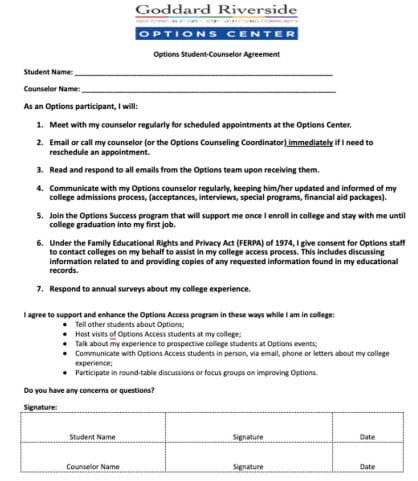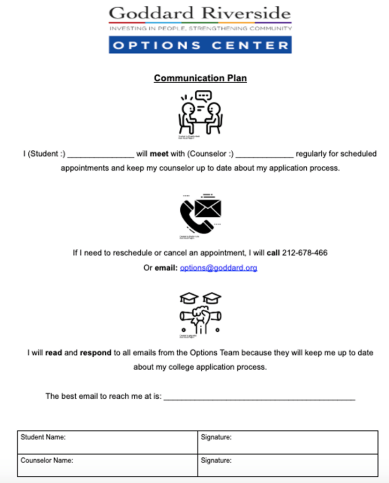In recent decades, behavioral scientists around the world have partnered with government agencies and large institutions to enhance program impact and solve pressing societal problems. However, this body of empirical research and its practical applications have not usually been accessible to the multitude of people on the front lines of service delivery, crisis response, and community building. The ideas42 Behavioral Design Center was established to help New York City non-profit staff identify and ameliorate behavioral barriers that emerge in service delivery and civic engagement efforts, with a particular focus on alleviating poverty. Through workshops, co-design projects, and Office Hour coaching sessions, the BDC teaches staff of community-based organizations (CBOs) how to apply behavioral approaches to reduce these barriers, increase the utilization of their services, and make good programs even more effective.
This is the second post in a series about BDC Office Hours, which allow our small team to provide a diverse array of non-profit program staff and managers with practical, individualized assistance in a timely manner. The first post in this series showcased examples of enhancing communications to better capture the target audience’s attention and make programs salient to people who could benefit from them. In this post, we’ll be taking a closer look at another of the most common themes:
- Overcoming obstacles to client engagement and persistence
Many of our Office Hour clients and project partners struggle with participant drop-off—people register for a program, attend some sessions or read some online materials, but then fail to respond to important program emails or texts, stop coming regularly, or don’t take advantage of online or community resources that would help them attain their goals.
Making Student Intake Agreement More Effective
For example, the Goddard Riverside Options Center, which supports New York City students in applying to and completing college, requested BDC help in revising the intake agreement that high school students fill out before beginning the college counseling program. In discussing what problem(s) were motivating the revision, we learned that students were not consistently reading and responding to program emails. These emails often contain time-sensitive information and requests related to the college application process. Therefore, our recommendations focused on how to make the agreement more engaging to the student reader, and more effective in encouraging consistent attention to program emails and ongoing communication between students and staff.
Agreement before and after
Results:
Based on our advice, the Options Center made significant changes, transforming the form from a text-dense page of eight legal-sounding agreements covering points from the initial phase of the program through the college years, to three short items. The new items, illustrated with icons, focus on facilitating communication between students and counselors, including language about how it benefits the student. To emphasize the collaborative nature of the relationship, the Options Center changed the title of the form from “Student Agreement” to “Communication Plan,” and removed “I will” student commitment statements. Counselors’ names and contact information are now prominently featured to make it easy for students to reach out to them.
Since making these revisions, program staff reported, “I can say that the conversation about communication and commitment seems much more genuine, inviting and holistic. In the past if felt sort of authoritative or instructional and now it feels much more like a conversation and a true agreement.”
Increasing Engagement with Online Workforce Development Materials
In another Office Hour, Upwardly Global, which provides job search training and resources to help professional immigrants, refugees, and asylees rebuild their careers in the U.S., requested advice on how to increase participation in its online training modules. Program staff were looking for strategies to increase engagement throughout the onboarding and training process, as well as guidance on optimal survey methods for getting course evaluation feedback. We offered suggestions on how to make it easier to select modules by making the presentation of multiple offerings less overwhelming, make the videos more appealing by featuring images of people like the target audience, and highlight users’ progress as they complete learning modules. To increase survey completion, we advised Upwardly Global to shorten it, and add information about the expected time the survey would take, as well as a progress bar.
Results:
A few weeks after our conversation, Upwardly Global staff shared via email, “We found the office hours session extremely valuable and timely for several ongoing projects at various stages of implementation! We have been actively preparing for the implementation our new Learning Management System. Based on our BDC office hours conversation, we have been applying the advice on 1) reducing intention-action gaps and 2)… adding a clear visual progress tracker that shows completed steps and next steps to these emails…we continue to explore options for how to effectively present our learning content in the new environment, keeping in mind the principle of paradox of choice and referring back to considerations for choice architecture. In developing the survey [for collecting course feedback], we considered much of the advice supplied from BDC, including narrowing down the number of questions and …explaining the value of sharing feedback.”
In addition to helping these and other clients address the specific problems presented to us during the Office Hour, we use the time to explain behavioral principles and strategies that can be applied to a variety of communications and operational challenges. Our short consultations help advance the BDC’s overarching mission to build lasting capacity across the City’s non-profit sector, enabling valued organizations to more effectively engage clients and improve outcomes for the individuals and communities they serve.
The next post in this series will showcase Office Hour consultations focused on helping programs learn about clients’ experiences in order to improve programs and service delivery. Stay tuned!





